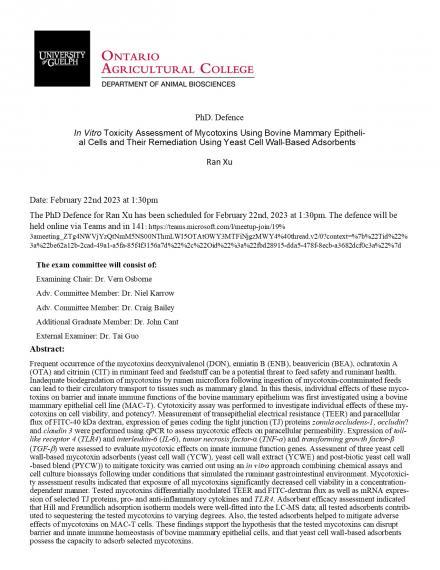Ran Xu's PhD Defence
Date and Time
Location
Teams and 141: https://teams.microsoft.com/l/meetup-join/19%3ameeting_ZTg4NWVjYzQtNmM5NS00NThmLWI5OTAtOWY3MTFiNjgzMWY4%40thread.v2/0?context=%7b%22Tid%22%3a%22be62a12b-2cad-49a1-a5fa-85f4f3156a7d%22%2c%22Oid%22%3a%22fbd28915-dda5-478f-8ecb-a3682dcf0c3a%22%7d

Details
Frequent occurrence of the mycotoxins deoxynivalenol (DON), enniatin B (ENB), beauvericin (BEA), ochratoxin A (OTA) and citrinin (CIT) in ruminant feed and feedstuff can be a potential threat to feed safety and ruminant health. Inadequate biodegradation of mycotoxins by rumen microflora following ingestion of mycotoxin-contaminated feeds can lead to their circulatory transport to tissues such as mammary gland. In this thesis, individual effects of these myco-toxins on barrier and innate immune functions of the bovine mammary epithelium was first investigated using a bovine mammary epithelial cell line (MAC-T). Cytotoxicity assay was performed to investigate individual effects of these my-cotoxins on cell viability, and potency?. Measurement of transepithelial electrical resistance (TEER) and paracellular flux of FITC-40 kDa dextran, expression of genes coding the tight junction (TJ) proteins zonula occludens-1, occludin? and claudin 3 were performed using qPCR to assess mycotoxic effects on paracellular permeability. Expression of toll-like receptor 4 (TLR4) and interleukin-6 (IL-6), tumor necrosis factor-α (TNF-a) and transforming growth factor-β (TGF-) were assessed to evaluate mycotoxic effects on innate immune function genes. Assessment of three yeast cell wall-based mycotoxin adsorbents (yeast cell wall (YCW), yeast cell wall extract (YCWE) and post-biotic yeast cell wall-based blend (PYCW)) to mitigate toxicity was carried out using an in vitro approach combining chemical assays and cell culture bioassays following under conditions that simulated the ruminant gastrointestinal environment. Mycotoxici-ty assessment results indicated that exposure of all mycotoxins significantly decreased cell viability in a concentration-dependent manner. Tested mycotoxins differentially modulated TEER and FITC-dextran flux as well as mRNA expres-sion of selected TJ proteins, pro- and anti-inflammatory cytokines and TLR4. Adsorbent efficacy assessment indicated that Hill and Freundlich adsorption isotherm models were well-fitted into the LC-MS data; all tested adsorbents contrib-uted to sequestering the tested mycotoxins to varying degrees. Also, the tested adsorbents helped to mitigate adverse effects of mycotoxins on MAC-T cells. These findings support the hypothesis that the tested mycotoxins can disrupt barrier and innate immune homeostasis of bovine mammary epithelial cells, and that yeast cell wall-based adsorbents possess the capacity to adsorb selected mycotoxins.